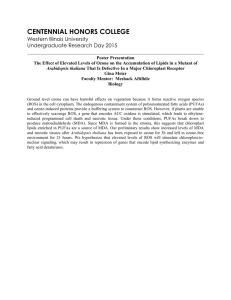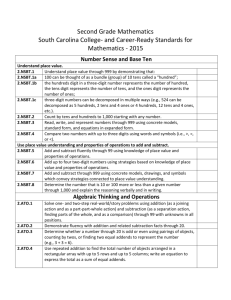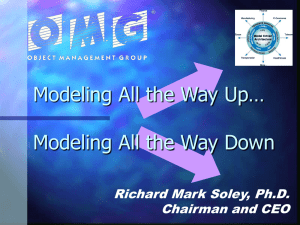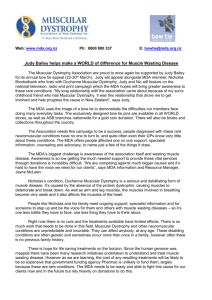Understanding tool requirements for Model Driven Architecture
advertisement
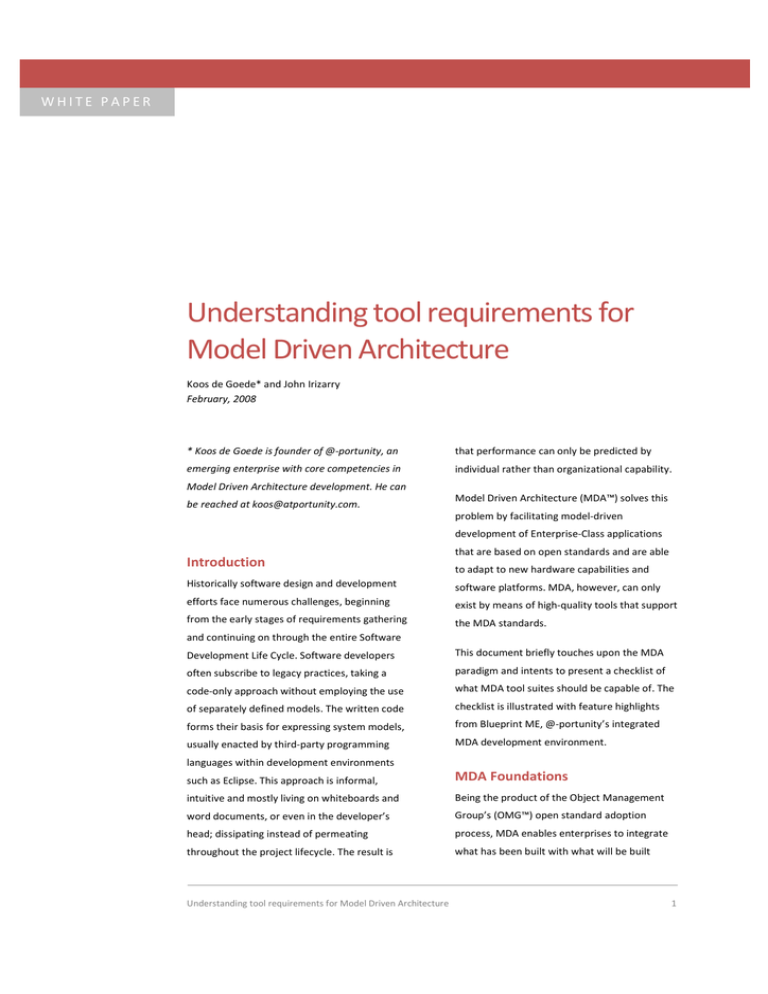
WHITE PAPER Understanding tool requirements for Model Driven Architecture Koos de Goede* and John Irizarry February, 2008 * Koos de Goede is founder of @-portunity, an that performance can only be predicted by emerging enterprise with core competencies in individual rather than organizational capability. Model Driven Architecture development. He can be reached at koos@atportunity.com. Model Driven Architecture (MDA™) solves this problem by facilitating model-driven development of Enterprise-Class applications that are based on open standards and are able Introduction to adapt to new hardware capabilities and Historically software design and development software platforms. MDA, however, can only efforts face numerous challenges, beginning exist by means of high-quality tools that support from the early stages of requirements gathering the MDA standards. and continuing on through the entire Software Development Life Cycle. Software developers This document briefly touches upon the MDA often subscribe to legacy practices, taking a paradigm and intents to present a checklist of code-only approach without employing the use what MDA tool suites should be capable of. The of separately defined models. The written code checklist is illustrated with feature highlights forms their basis for expressing system models, from Blueprint ME, @-portunity’s integrated usually enacted by third-party programming MDA development environment. languages within development environments such as Eclipse. This approach is informal, MDA Foundations intuitive and mostly living on whiteboards and Being the product of the Object Management word documents, or even in the developer’s Group’s (OMG™) open standard adoption head; dissipating instead of permeating process, MDA enables enterprises to integrate throughout the project lifecycle. The result is what has been built with what will be built Understanding tool requirements for Model Driven Architecture 1 WHITE PAPER based on well-established and open standards. • Platform independency In MDA, models, expressed in a well-defined • Domain specificity notation, are the cornerstone in defining and • Productivity understanding systems. Models are created at • Uniformity different levels of abstraction, separating the • Consistency concerns of the business from the technical details of the actual software solution to be Platform independency developed. Basically, three different types of MDA greatly reduces the time, cost and models are constructed: one that contains the complexity associated with re-targeting business specifications, one for the high level applications for different platforms, including details of the platform and one that includes those yet to be introduced. technical details of the target platform. By describing these models through a set of metamodels, transformation amongst models is facilitated, ultimately resulting in code generation. “ Domain specificity MDA enables implementations of industry specific applications over diverse platforms, through domain specific meta-models. Productivity “MDA enables enterprises to integrate what has been built with what will be built based on wellestablished and open standards.” ” MDA Benefits The bottom-line benefits of MDA are significantto business leaders and developers alike: reduced cost throughout the application lifecycle reduced development time for new applications and improved quality of even more complex systems. Moreover MDA allows for MDA increases productivity, by permitting developers, designers and system administrators to use languages and concepts they are comfortable with, while enabling seamless communication and integration across the teams. Uniformity As from the onset, models and their definitions are structured to achieve consistency yielding applications that are implemented in a uniform manner; MDA increases the quality and robustness of the end product. rapid inclusion of emerging technology benefits Consistency into existing systems. The realization that Through the ability to perform bi-directional modeling is critical to the success of every transformations, MDA assures that all models enterprise-scale solution forms the impetus for reflect current-state consistently. a growing consensus that MDA promotes: Understanding tool requirements for Model Driven Architecture 2 WHITE PAPER MDA Standards The definition of the MDA concept started late 2000 using OMG’s open standard adoption process, only to reach maturity with the definition of the QVT specifications in 2007. The definite MDA standards require models to be MOF-based model or meta-model that cannot otherwise be expressed by diagrammatic notation. XML Metadata Interchange (XMI) XMI is a model driven XML Integration framework for defining, interchanging, compliant with OMG’s Meta-Object Facility manipulating and integrating XML data and (MOF™). This guarantees that all models can be objects. XMI-based standards are in use for related to each other in order to be parsed, integrating tools, repositories, applications and transferred, stored and transformed. More data warehouses. concrete, the following standards must be integrated in an MDA development Query/View/Transformation (QVT) environment in order to support the start-to- QVT is a standard for writing transformation end model-driven development cycle: specifications between MOF based metamodels. A QVT engine is able to execute • Meta-Object Facility (MOF) transformations and create (or update) a target • Unified Modeling Language (UML) model from a source model. • Object Constraint Language (OCL) • XML Metadata Interchange (XMI) Model-to-Text (M2T) • Query/View/Transformations (QVT) M2T enables transformations of models to • Model-to-Text (M2T) various text artifacts such as code, deployment specifications, reports and application Meta-Object Facility (MOF) documentation. MOF™ is an extensible model driven integration framework for defining, manipulating and Tool Ecosystem: Polluted integrating meta-data and data in a platform Even before the crystallization of OMG’s MDA independent manner. standards, the tooling ecosystem attained a Unified Modeling Language (UML) UML® is a standardized specification language for object modeling. It is a general-purpose modeling language that includes a graphical notation used to create an abstract model of a system. new category: MDA tools. Many of these tools claim to enable MDA development, but reality shows that only the code-generation part of MDA is supported. As a result, model-driven development has become a buzzword, the main objective believed to be the automation of 100% code generation. On the contrary, MDA Object Constraint Language (OCL) should be used advantageously at various OCL is a precise text language that provides stages of the Software Development Life Cycle constraint and object query expressions on any in order to enrich development methodologies Understanding tool requirements for Model Driven Architecture 3 WHITE PAPER and to enforce architecture conformance. The Meta-modeling key technologies embodied within MDA tools The meta-modeling facility combines the should be focused towards enabling developers creation of meta-models and UML Profiles. to maximize their activities during the MDA Meta-models can be considered as an explicit process. description of how a domain-specific model is built. As UML alone is not able to represent the Towards a Healthy Ecosystem semantics of a meta-model in a convenient way, Essential to any MDA tool is the need to UML profiles are used to provide additional integrate all required technologies. Blueprint queries and constraints to a UML model. Modeling Environment (Blueprint ME) is the first integrated MDA modeling and development environment offering interoperability of all ingredients of the MDA process. “ UML modeling The UML modeling facility includes a UML 2.1 compliant visual modeler that supports UML profiles and constraint validation. The UML modeler’s hierarchical process structure facilitates the orderly construct of flows “Many MDA tools claim to enable Model-driven development, but reality shows that only the code-generation part of MDA is supported.” ” Based upon and fully integrated with the Eclipse IDE, Blueprint ME is an extendible environment that allows integration with a variety of programming languages and features the following facilities in line with OMG’s MDA standards. depicting the MDA process. Model-to-model transformations The model-to-model transformation facility enables the definition of model transformations. This facility is based on QVT Operational and includes a highly intuitive graphical user interface that features test and debug facilities. Within the model-to-model transformations facility, users can associate models through drag and drop operations and define the structure of the transformation • Meta-modeling model. The specifics of every operation can be • UML modeling defined using a property editor that guides the • Model-to-model transformations user towards further definition of • Model-to-text transformations transformation centric rules. Step-by-step • Transformations execution analysis and test of transformations are handled • Model repository by the integrated transformation debugger. Historical data on transformations is maintained and recorded. Understanding tool requirements for Model Driven Architecture 4 WHITE PAPER Model-to-text transformations The model-to-text transformation facility permits the design of artifacts in compliance with the M2T standard. The interface includes split window editors that separate template definition from the queries. The M2T implementation is template driven. Textual artifacts can be generated in arbitrary forms supporting regeneration without loss of manual changes made to previously generated output. The template editor can be extended with a user defined syntax coloring scheme. Transformation execution engine The transformation execution engine enables Usability Last but not least, usability is a key factor when it comes to MDA tool suites. The most important usability requirements are the interoperability between the various standards and the integration of these standards and facilities in one single development environment. Blueprint ME combines those requirements with a highly intuitive user interface including features like real-time transformation debugging that allows users – both experienced and novice – to understand the complexity of MDA and unleash the power of model-driven development. the user to define workflows to perform multiple sequential transformations (both QVT “ and M2T). Workflows can be defined in a way Blueprint ME integrated MDA IDE that the output of one transformation is the Blueprint ME, is the first integrated modeling input of the next. environment that allows end users to effectively produce complete designs in compliance with “Last but not least, usability is a key factor when it comes to MDA tool suites.” ” OMG's Model Driven Architecture standards (MOF, UML, OCL, XMI, QVT and M2T). To find out more about Blueprint ME, please visit www.atportunity.com. Model repository The model repository facilitates storage for reusable modeling artifacts. The repository includes versioning and keeps track of artifact changes. The model repository allows storage of Models, meta-models, UML profiles, UML libraries, transformations and workflow definitions. Understanding tool requirements for Model Driven Architecture 5 WHITE PAPER About @-portunity @-portunity is an emerging enterprise with core competencies in Model Driven Architectures. Our management team is comprised of seasoned professionals with years of collective experience in the areas of Software Architecture Development, and advanced Software Development Methodologies as applied in resolving real world situations. Our flagship product, the Blueprint Modeling Environment, is the first integrated suite of tools that allows end users to effectively produce complete designs in compliance with OMG's Model Driven Architecture standards. @-portunity is member of the Object Management Group™. To find out more visit us at www.atportunity.com. © Copyright 2008 @-portunity B.V. No part of this publication may be reproduced or transmitted by any form or by any means without the prior written permission of the publishers. All registered trademarks and copyrights are understood and recognized by @-portunity.

